Ownership: Ready to fly when you are
Keeping your aircraft in flying condition

This routine will often continue until the aircraft is sold; however, sometimes our once-beloved airplanes are flown less frequently over time. Tires begin to go flat; a bird’s nest appears under the cowl; and the ailerons are left to flap in the breeze.
Although there are many reasons an aircraft may go unused for a period of time—work and family commitments, finances, and health, to name a few—waiting too long between flights or visits to the airport could lead to your airplane becoming unairworthy. Just as pilots need some level of proficiency to remain safe to fly, our aircraft require a minimum level of ongoing care to remain safe to fly, too. In the worst case, deferred maintenance could lead to your airplane not being ready to fly when you are.
How can you prevent your joy of aircraft ownership from turning into a frustrating waste of money? A few essential steps can help keep your aircraft ready to launch on its next adventure.
Email [email protected]
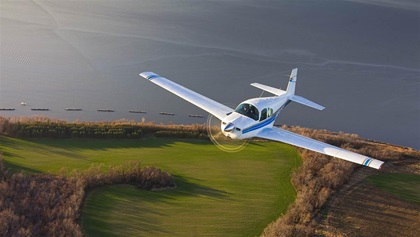 Fly regularly, even if the flight is short. Thirty minutes in the pattern (ensure the engine reaches an oil temperature of at least 180 degrees F to burn off any water in the oil) will keep moving parts lubricated and birds and pests out of the aircraft. It will also help you remain current and proficient in the airplane. Mechanics I’ve worked with have observed that a higher-time engine flown regularly will be more reliable—and is more likely to reach TBO and beyond—than a lower-time engine flown only a few times each year. Based on that wisdom, my own goal is to fly my airplane at least weekly.
Fly regularly, even if the flight is short. Thirty minutes in the pattern (ensure the engine reaches an oil temperature of at least 180 degrees F to burn off any water in the oil) will keep moving parts lubricated and birds and pests out of the aircraft. It will also help you remain current and proficient in the airplane. Mechanics I’ve worked with have observed that a higher-time engine flown regularly will be more reliable—and is more likely to reach TBO and beyond—than a lower-time engine flown only a few times each year. Based on that wisdom, my own goal is to fly my airplane at least weekly.
I can’t stress enough that flying regularly is completely different than running the engine regularly while still on the ground. You can cause long-term damage to your engine by starting it occasionally with no intention of flying. Condensation will form very quickly inside the engine, and the oil temperature will never get hot enough to evaporate that water. Each time you start and stop the engine, a fresh batch of water is produced, and internal engine rust can occur. Rust inside an engine is never a good thing.
“When it comes to maintenance, don’t ignore a small problem because it will usually become a bigger problem down the road. It’s usually a case of pay me now or pay me later—but it might be a bigger bill later.” —Jill W. Tallman, senior editor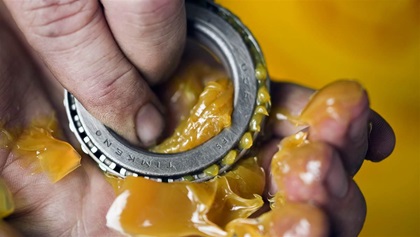 Lubricate every moving part. Creaky doors, stiff trim wheels, stubborn fuel selectors, and sticking controls are not only bad for the longevity of these components, but also make flying your airplane far less enjoyable. For the price of a spray can of lubricant and 15 minutes of effort, everything on your aircraft can operate smoothly and quietly—but check with your mechanic or POH to make sure you are using the correct type of lubricant or grease for each moving part. This is one of many preventive maintenance items a pilot-owner may perform on their aircraft. A more extensive list can be found in FAR Part 43, Appendix A, Paragraph C.
Lubricate every moving part. Creaky doors, stiff trim wheels, stubborn fuel selectors, and sticking controls are not only bad for the longevity of these components, but also make flying your airplane far less enjoyable. For the price of a spray can of lubricant and 15 minutes of effort, everything on your aircraft can operate smoothly and quietly—but check with your mechanic or POH to make sure you are using the correct type of lubricant or grease for each moving part. This is one of many preventive maintenance items a pilot-owner may perform on their aircraft. A more extensive list can be found in FAR Part 43, Appendix A, Paragraph C.
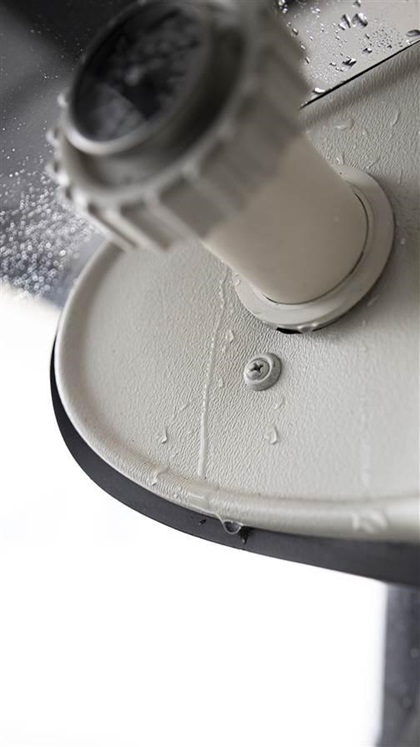 Leaks kill airplanes from the inside out. If you discover any water leaks, fix them as soon as possible. Most water leaks can be fixed fairly inexpensively when they first appear. If left uncorrected, leaks will cause interiors to get wet and mildew; the aircraft structure can oxidize or rust; and avionics and electrical wiring can be damaged. The tricky part about water leaks is that they are not always easy to detect. Telltale signs include wet headliners or carpeting, a mildew odor, excess condensation forming on the inside of the windows, and pools of water in the lowest parts of the aircraft fuselage and tail (in the bare aluminum area behind the baggage compartment). While you are looking in this area, make sure any drainage holes (which are typically along the bottom centerline of the airplane) are unobstructed. These holes exist to drain any water that enters your airplane, to reduce the possibility of internal corrosion.
Leaks kill airplanes from the inside out. If you discover any water leaks, fix them as soon as possible. Most water leaks can be fixed fairly inexpensively when they first appear. If left uncorrected, leaks will cause interiors to get wet and mildew; the aircraft structure can oxidize or rust; and avionics and electrical wiring can be damaged. The tricky part about water leaks is that they are not always easy to detect. Telltale signs include wet headliners or carpeting, a mildew odor, excess condensation forming on the inside of the windows, and pools of water in the lowest parts of the aircraft fuselage and tail (in the bare aluminum area behind the baggage compartment). While you are looking in this area, make sure any drainage holes (which are typically along the bottom centerline of the airplane) are unobstructed. These holes exist to drain any water that enters your airplane, to reduce the possibility of internal corrosion.
Protective coverings. If your aircraft is stored outside, it can incur damage every day in many ways. The sun’s UV light and grit blowing in the wind attack windows and paint—slowly dulling their surfaces. Intense heat generated from direct sunlight can also damage avionics and plastic interior trim. Rain, snow, ice, hail, and wind all conspire to soak, freeze, and beat your airplane into submission. And, pests of every variety will do their best to make your airplane their cozy home. However, you can help prevent these hazards from damaging your airplane. Plug holes where birds and animals can enter and consider aircraft covers to protect the exterior and interior. Quality pays off here and, although not inexpensive, buying the best cabin cover and cowl plugs you can afford not only will maintain your aircraft in flying condition, they also will preserve the value of your aircraft when it comes time to sell.
“When I was a poor college student, I did most of the maintenance on my ’70s-era Chevy. When I bought an airplane, I was too intimidated to work on it—even though it was simpler than my car—until I assisted in a couple of annual inspections. Now I routinely do my own oil changes and other minor chores, and find it a great way to stay in touch with the health of the airplane.” —Tom Haines, editor in chief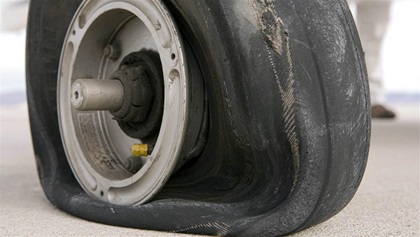 Keep tires properly inflated. Underinflated tires can develop flat spots while sitting in the same position for an extended period of time, leading to vibration during taxi, takeoff, and landing. A completely flat tire may need more than just air. If your tires continually lose air, consider cleaning or replacing the valve stem core first. It’s a cheap and easy replacement item. If that does not solve the problem, replace the tubes (this is another item you can perform as preventive maintenance). Tubes should be replaced with each tire change, although they often are not—it’s relatively cheap insurance against future flat tires.
Keep tires properly inflated. Underinflated tires can develop flat spots while sitting in the same position for an extended period of time, leading to vibration during taxi, takeoff, and landing. A completely flat tire may need more than just air. If your tires continually lose air, consider cleaning or replacing the valve stem core first. It’s a cheap and easy replacement item. If that does not solve the problem, replace the tubes (this is another item you can perform as preventive maintenance). Tubes should be replaced with each tire change, although they often are not—it’s relatively cheap insurance against future flat tires.
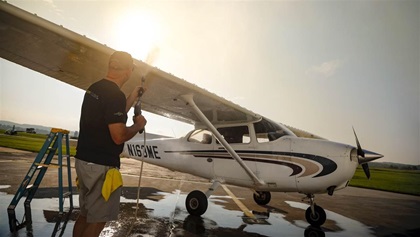 A clean airplane is a happy airplane. I’d rather be flying my airplane than cleaning it. Most of the time, a quick rinse and wipe down is about as much as my airplane can expect from me. There is a huge hidden benefit to the occasional thorough washing, and that is spotting squawks you may not notice during your routine preflights. While towel drying the airplane you’ll notice missing screws, loose nuts, cracked aluminum skin, and more that is easily remedied now but could turn into a major issue if left unfixed.
A clean airplane is a happy airplane. I’d rather be flying my airplane than cleaning it. Most of the time, a quick rinse and wipe down is about as much as my airplane can expect from me. There is a huge hidden benefit to the occasional thorough washing, and that is spotting squawks you may not notice during your routine preflights. While towel drying the airplane you’ll notice missing screws, loose nuts, cracked aluminum skin, and more that is easily remedied now but could turn into a major issue if left unfixed.
“Engine heat. I’ve got a plug-in Tanis heating system that warms the engine block and cylinders as well as the oil sump. I also cover the cowl with a thick blanket and install cowl plugs to keep the warmth from the heater inside the engine compartment. Even on the coldest winter days, it keeps the entire engine compartment warm and reduces wear on startup.” —Dave Hirschman, editor at largeRegular oil changes are the cheapest insurance to protect your engine. Engines with an oil filter should have their oil and filter changed every 50 hours (or as prescribed in your POH or maintenance manual). Engines with only an oil screen (such as my Cessna 140) require an oil change and screen cleaning every 25 hours. If you fly less frequently, the oil should be changed annually regardless of how many hours are put on the engine. This is more to retain the oil’s ability to scavenge unwanted combustion deposits than it is to maintain the oil’s lubricating qualities. Although many owners like to send an oil sample out for analysis with each oil change, an annual analysis is likely sufficient for most owner-flown aircraft.
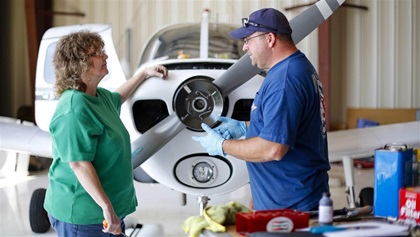 Keep your aircraft in annual. Annual inspections can be the most expensive part of ownership. Often, the first annual under your ownership is the most stressful. Your mechanic will find plenty to fault, but remember that you have the final say over what is repaired or replaced beyond required airworthiness discrepancies. Your airplane doesn’t have to be perfect—just safe. Elective repairs and replacements can be safely deferred until you’re ready to make the investment. Subsequent annuals often are far less expensive, particularly if you stay with the same mechanic—as he or she will become familiar with your airplane and have fewer nits to pick each passing year. Even if your airplane doesn’t fly much, completing an annual every year means it will remain legal to fly, and not grounded until one can be accomplished. If cost is an issue, consider an owner-assisted annual. You’ll do most of the work under the watchful eye of your A&P/IA—and the time spent crawling around the hidden areas of your airplane can be quite educational.“One of the most helpful items I bought early on was a flexible, lighted borescope. They’re cheap, plug into an iPhone, and give you great visibility into your engine, and other hard-to-access places on your airframe. I often borescope my engine at oil change. It’s easy, and…it’s interesting!” —Richard McSpadden, executive director, AOPA Air Safety Institute
Keep your aircraft in annual. Annual inspections can be the most expensive part of ownership. Often, the first annual under your ownership is the most stressful. Your mechanic will find plenty to fault, but remember that you have the final say over what is repaired or replaced beyond required airworthiness discrepancies. Your airplane doesn’t have to be perfect—just safe. Elective repairs and replacements can be safely deferred until you’re ready to make the investment. Subsequent annuals often are far less expensive, particularly if you stay with the same mechanic—as he or she will become familiar with your airplane and have fewer nits to pick each passing year. Even if your airplane doesn’t fly much, completing an annual every year means it will remain legal to fly, and not grounded until one can be accomplished. If cost is an issue, consider an owner-assisted annual. You’ll do most of the work under the watchful eye of your A&P/IA—and the time spent crawling around the hidden areas of your airplane can be quite educational.“One of the most helpful items I bought early on was a flexible, lighted borescope. They’re cheap, plug into an iPhone, and give you great visibility into your engine, and other hard-to-access places on your airframe. I often borescope my engine at oil change. It’s easy, and…it’s interesting!” —Richard McSpadden, executive director, AOPA Air Safety Institute
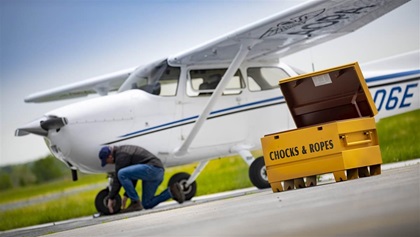 Install a storage box. It’s a lot easier to lubricate, inflate, clean, and protect your airplane when you have the proper tools and supplies handy. If your aircraft is tied down outside, these can be conveniently kept in an appropriate outdoor storage box. While I’m sure everyone would love to store their airplane in a hangar—with the accompanying room for a large toolbox—in many cases they are expensive or unavailable. Ask the airport manager if you can install a storage box near your tiedown. The box needs to be hefty enough not to be blown by 50-knot-plus winds (for example, constructed from steel), or chained to a pole, fence, or other immovable object. Consider that your biggest liability is damaging another aircraft, so make sure the storage box is completely secure.“My Cessna 170B’s paint job was weathered (to say the least) when I bought it, and I had to keep it tied down on the ramp for a year or so before getting into a hangar. I wanted to protect it as much as possible from the elements, so I thoroughly scrubbed it by hand with a cleaning compound and then waxed it and used airplane covers. It looked like I had taken two decades of grime off, and it was protected by the wax. All it took was time and elbow grease, all of which I was happy to do for my first airplane purchase.” —Alyssa Cobb, senior director, eMedia
Install a storage box. It’s a lot easier to lubricate, inflate, clean, and protect your airplane when you have the proper tools and supplies handy. If your aircraft is tied down outside, these can be conveniently kept in an appropriate outdoor storage box. While I’m sure everyone would love to store their airplane in a hangar—with the accompanying room for a large toolbox—in many cases they are expensive or unavailable. Ask the airport manager if you can install a storage box near your tiedown. The box needs to be hefty enough not to be blown by 50-knot-plus winds (for example, constructed from steel), or chained to a pole, fence, or other immovable object. Consider that your biggest liability is damaging another aircraft, so make sure the storage box is completely secure.“My Cessna 170B’s paint job was weathered (to say the least) when I bought it, and I had to keep it tied down on the ramp for a year or so before getting into a hangar. I wanted to protect it as much as possible from the elements, so I thoroughly scrubbed it by hand with a cleaning compound and then waxed it and used airplane covers. It looked like I had taken two decades of grime off, and it was protected by the wax. All it took was time and elbow grease, all of which I was happy to do for my first airplane purchase.” —Alyssa Cobb, senior director, eMedia
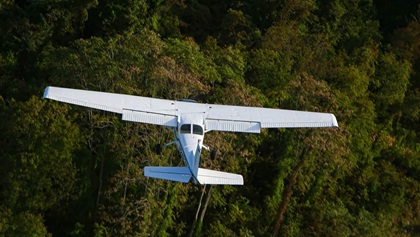 Hire an airplane sitter. What if you can’t fly your airplane for a long period of time because of travel or health reasons? Consider hiring an airplane sitter—someone who can fly your airplane occasionally. It could be a pilot friend or a CFI or a ferry pilot with time in type. A CFI may be willing to fly your aircraft as a tradeoff for earning precious hours toward their airline transport pilot certificate. While you may not like the idea of someone else flying your baby, your airplane will greatly benefit from regular use and remain ready for the time you want to take it skyward. Check with your insurance company to see if you have an open pilot endorsement, which will allow any current pilot with the required number of hours in your make and model of aircraft to fly your airplane and be covered by your insurance. Otherwise, you’ll need to add a named pilot to your insurance policy.
Hire an airplane sitter. What if you can’t fly your airplane for a long period of time because of travel or health reasons? Consider hiring an airplane sitter—someone who can fly your airplane occasionally. It could be a pilot friend or a CFI or a ferry pilot with time in type. A CFI may be willing to fly your aircraft as a tradeoff for earning precious hours toward their airline transport pilot certificate. While you may not like the idea of someone else flying your baby, your airplane will greatly benefit from regular use and remain ready for the time you want to take it skyward. Check with your insurance company to see if you have an open pilot endorsement, which will allow any current pilot with the required number of hours in your make and model of aircraft to fly your airplane and be covered by your insurance. Otherwise, you’ll need to add a named pilot to your insurance policy.



